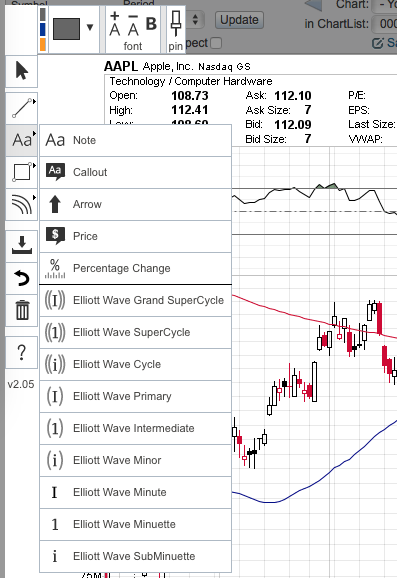Table of Contents
Text Annotation Tools
ChartNotes' Text Annotation tools allow you to add descriptions and symbols to your charts. Watch our Text Tools video or read on below to learn more about how to use and apply these utilities.
The Text Tools Menu
Each of the Text Tools available in ChartNotes is listed and described below in more detail. Here is a screenshot of where you can find the Text Tools menu:

Text Note
The Text Note tool lets you add text without any background to your chart. After clicking on the “Text Note” button, click on your chart in the general area where you want your note to be and enter your desired text in the box that subsequently appears. Then, hold down the CTRL key (CMD for a Mac) and press Enter.
At that point, your text will appear on the chart in the currently selected color and font size. You can modify the text properties using the horizontal menu at the top of the chart. Additionally, dragging the yellow handles at the edges of your text will allow you to resize and reposition the text box.
Callout Boxes
The Callout Box tool allows you to add white “text bubbles” that appear to float slightly above your chart. Once created, you can add “callout points” to the bubble that connect it visually to specific locations on your chart.
After clicking on the “Callout Box” button, click on your chart in the general area where you want your Callout Box to be and enter your desired text in the box that subsequently appears. Then, hold down the CTRL key (CMD for a Mac) and press Enter.
At that point, your text will appear on the chart inside of a white “balloon” using the currently selected color and font size. You can modify the text properties using the horizontal menu at the top of the chart. Additionally, dragging the yellow handles at the edges of your text will allow you to resize and reposition the balloon.
You can add “points” to your callout box by holding down the CTRL/CMD key, then clicking and dragging away from the center of the box to the location you want to point to.
Note: Callout Points cannot be deleted. You can hide unwanted points behind the text balloon.
Arrows
The Arrow tool adds small arrow shapes to a chart, which can point either left, right, up or down. These are useful for indicating where signals or significant events occur on a chart.
After selecting the Arrow tool, click on the chart in the area you want to place the head of the arrow, then drag in the direction you want the tail to be. The arrow will appear as you drag your mouse.
To reposition the arrow, use the selection tool to select the arrow you would like to move. Then, click on the yellow box or “handle” at the point of the arrow and drag.
Price Boxes
The Price Box tool allows you to add a box with price information to your chart.
After selecting the Price Box tool, simply move your mouse to the location you want to mark and click your mouse button. A text “bubble” will appear with the chart's closing price at that particular time period inside of it.
Note: After a Price box has been added to the chart, it behaves exactly like a Callout Box with one callout point.
Percent Change Tool
The Percent Change tool allows you to measure the vertical percentage difference between prices on two different parts of the chart.
After selecting the Percent Change tool, just click and drag from one point to the other. A vertical percentage measurement will appear on the chart and change as you drag.
Elliott Wave Labels
The Elliott Wave Label tool allows you to quickly add numbered Elliott Wave labels to your chart. For more information on Elliott Waves, please review our ChartSchool article on Elliott Wave Theory.
When you click on the Text Annotation menu, there will be a choice of 9 different Elliott Wave notation styles. Click on the style that you want to use to select it. At that point, your “Wave Number” will be set to one. Each time you click on your chart, a new notation will be added at that location and the “Wave Number” will be incremented.
Note: Once they have been added to the chart, Elliott Wave numbers are treated just like any other regular Text Note annotation.